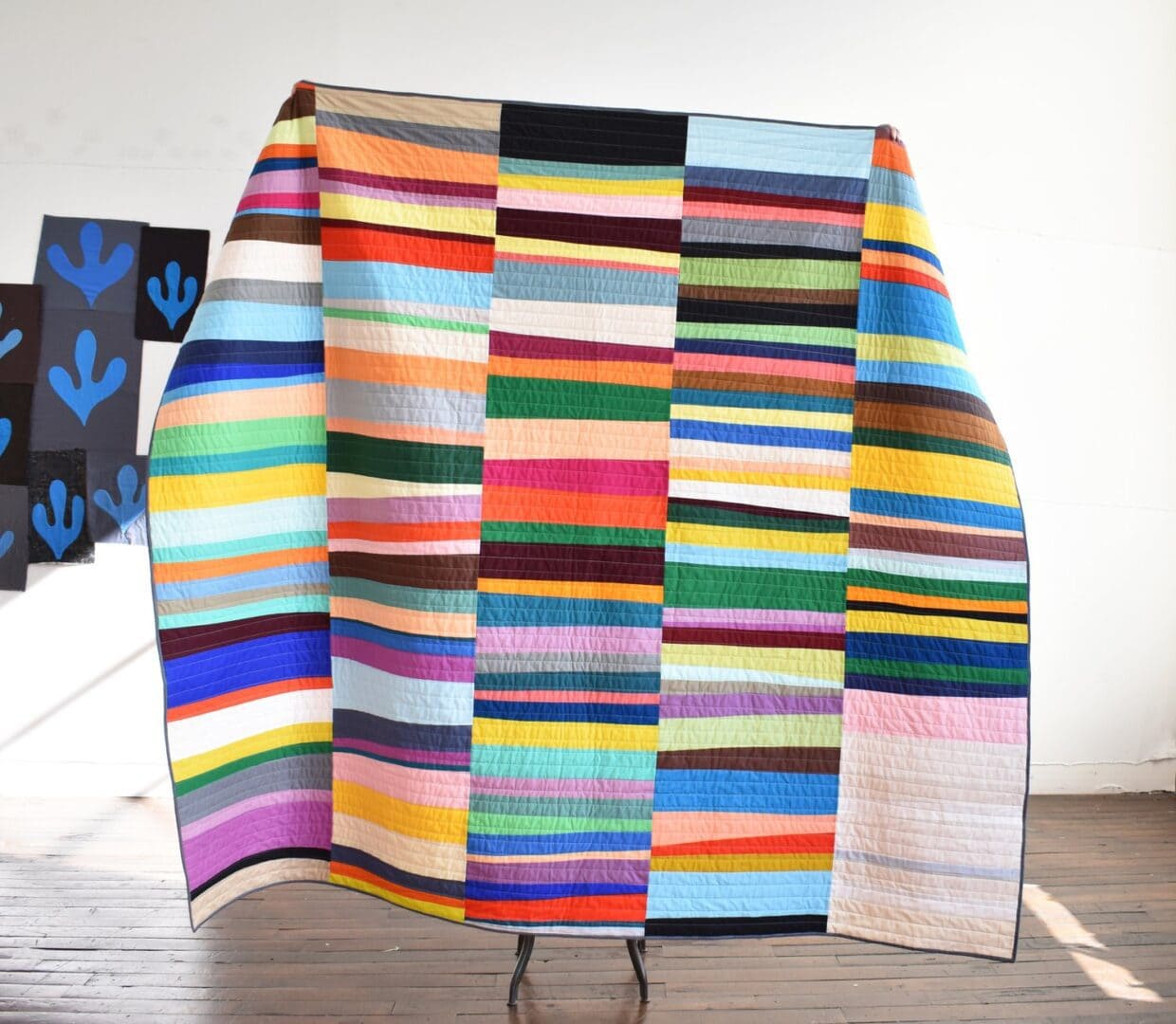
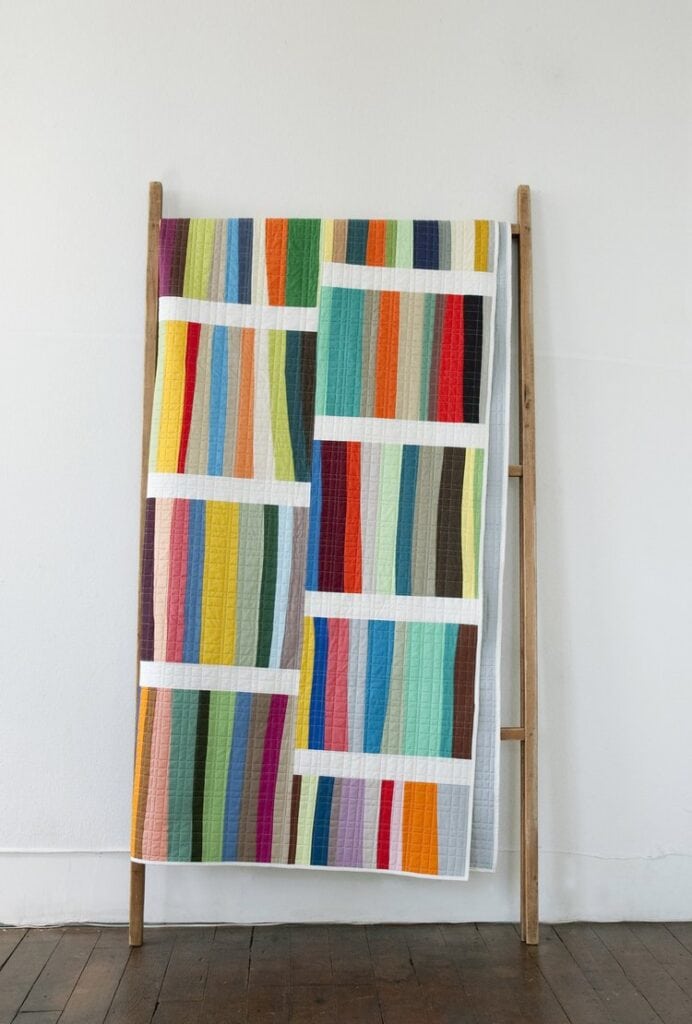
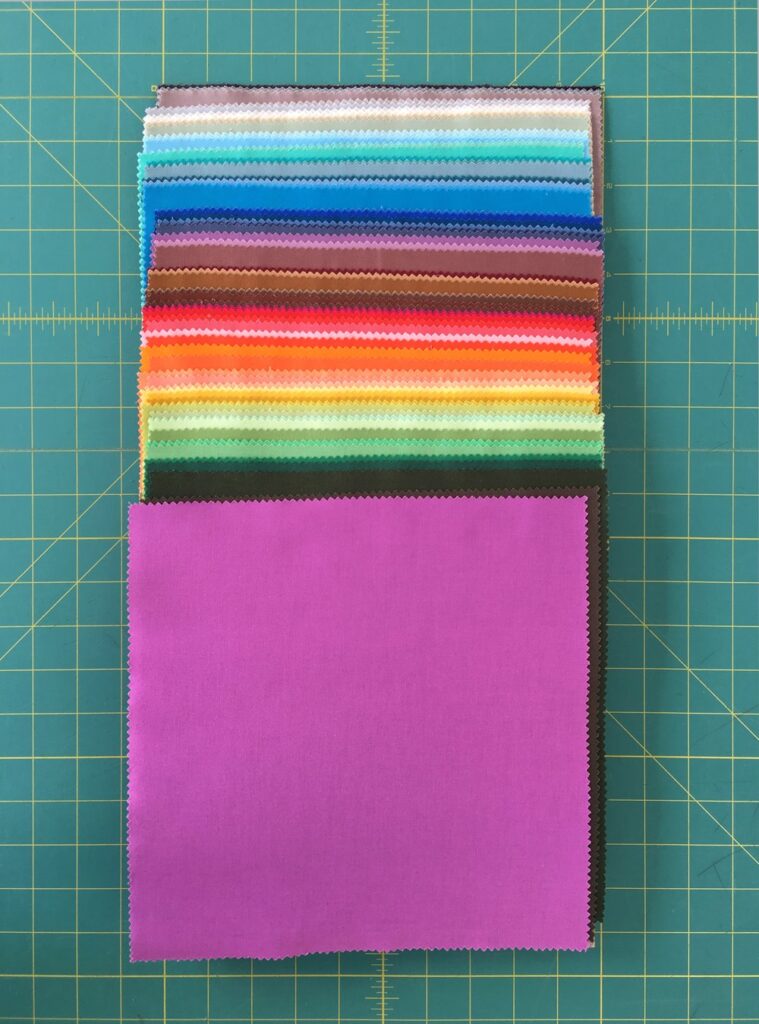
Tatter talks to artist Denyse Schmidt about her practice and relationship to quilting, teaching, and showing makers how to push themselves and facilitate flow.
What is your earliest memory of a textile? An important textile from your childhood?
I am not sure I know my earliest memory, but I remember the fabric of clothes and objects I had as a kid – a moss green flannel skirt (including a metal link belt that had a “coin” on one end of it); my sleeping bag for sleepover parties that was an inky navy blue with GIANT daisies in white, red, and mustard. My mom sewed—she made clothes for herself and us four kids, and I loved hanging around her fabric stash. She also took me with her fabric shopping with her. Back then we went to the red-brick mill buildings so prevalent in central New England, where fabrics had been made for decades. The dusty old buildings had beautiful layers of signage painted on the sides, circuitous halls and rooms with creaky wooden floors, and rolls and rolls of fabrics stacked on tables and the shelves underneath.
What made you choose quilting as your primary medium?
I had gone back to school in my late 20s and studied graphic design. I did that for a while, but found it frustrating to spend so many hours on the details of typography and spacing, something most people never noticed, for things that ultimately would get tossed. There was a confluence of events in my life at that time that lead to the unlikely idea of making quilts for a living. Too long to go into in detail but 1. Falling in love with old-time Appalachian music; 2. It was the heyday of Martha Stewart Living magazine which elevated the genre of women’s magazines (and domesticity) with beautiful design; and 3. Coming across a copy of Abstract Design in American Quilts: A Biography of an Exhibition by Jonathan Holstein and Shelley Zegart. Up to that point, I had only seen books of fancy, perfecty-perfect quilts – made by women with time on their hands for show or display. Those quilts were beautiful, but very traditional and sometimes rigidly regular. Jonathan Holstein collected quilts for their startling resemblance to contemporary painters in the 70s, and they weren’t necessarily “good” quilts by the standards of the quilt industry. But they were amazing – minimalist, graphic, weird.
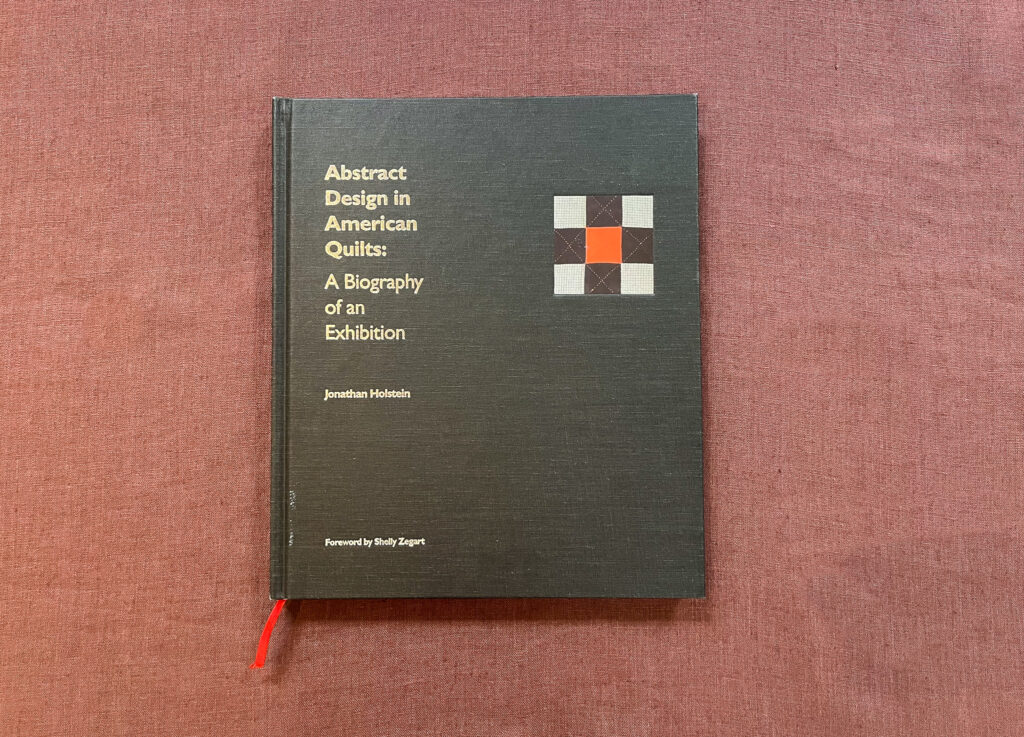
How do you select the textiles and fibers that you use in your quilts?
It depends on the intention of the quilt. For the quilts I made when I first started my business, I used mostly solid fabrics (not as plentiful then as now), with details of vintage prints or wovens. Once I started designing fabric for the quilt industry, I began designing patterns to showcase the collections – those quilts tend to use all the prints in a collection against a solid background. My preference, when I have the rare opportunity to make with no client or agenda, is still to mix and match new and old. I love making things that feel timeless. Sometimes a fabric I find at a flea market or yard sale might be the starting point for a quilt design, or a particular concept or idea I want to explore will dictate what fabrics I need to find to best express that idea.

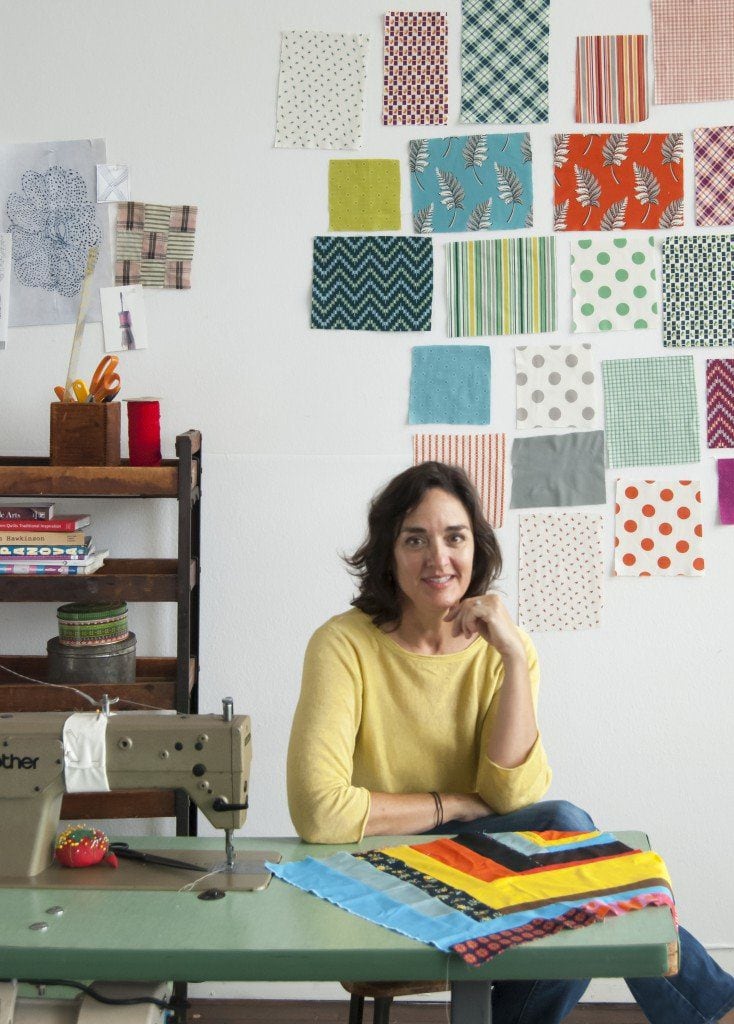
What is your process when improvising a quilt? How do you immerse yourself in improvisation and spontaneity? What is your relationship to color? How do you go about making a limited or specific palette?
I find the process works best for me when I establish parameters to work within. At RISD, I had a class on design systems with a guy who was a little out there, but the concepts he taught stuck with me. It doesn’t matter what the parameters are – in many ways choosing “markers” or limits arbitrarily works best because it becomes an element, not something you are tied to emotionally that can distract you. Josef Albers said his students did their best Color-Aid paperwork when they had used up all their favorites and were left with colors they liked the least! There is something about that detachment that allows for freedom from needing a particular outcome. Some of the early quilts I really love and am inspired by have idiosyncracies—an oddball fabric substitution or random shape that draws me in. I could be wrong, but sometimes these elements seem to be improvisations in the moment—the maker ran out of a certain fabric and used what was on hand. I like that solution from a practical and aesthetic standpoint. When we are too invested in our choices (like a favorite fabric we’ve been saving for the “right” project) or the outcome, it is very hard to be open to discovery.
Another key for me to working improvisationally is to make my working environment as “smooth” as possible. I bring out all the materials I intend to use, all my tools are ready, the machine threaded, bobbins wound, everything is at hand and ready to go. If I encounter tension issues with my machine, or if I have to go looking for something in the middle of working, I know I will get sidetracked and it will take too much time and psychic energy to get back in the groove. I call this “no rough edges” or places/things I can potentially get hung up on. I perform best when I can control the chaos a bit, so I use shallow boxes (the short-sided boxes my cat food cans come in are perfect) to keep my scraps somewhat organized as I work.
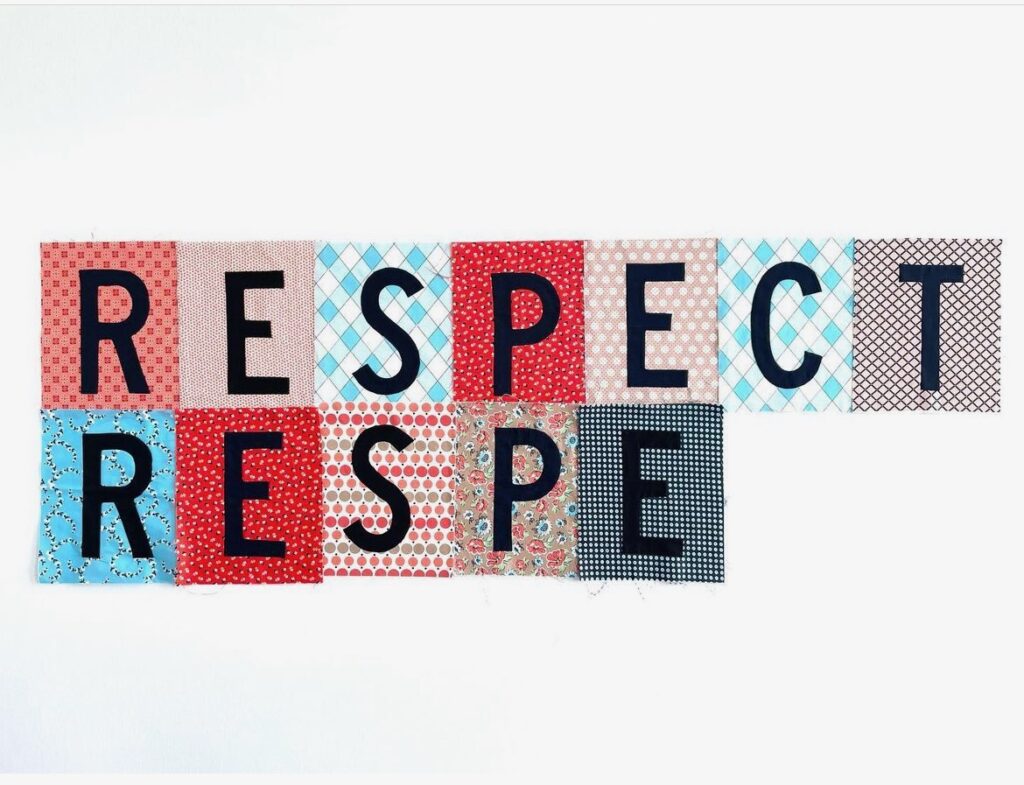
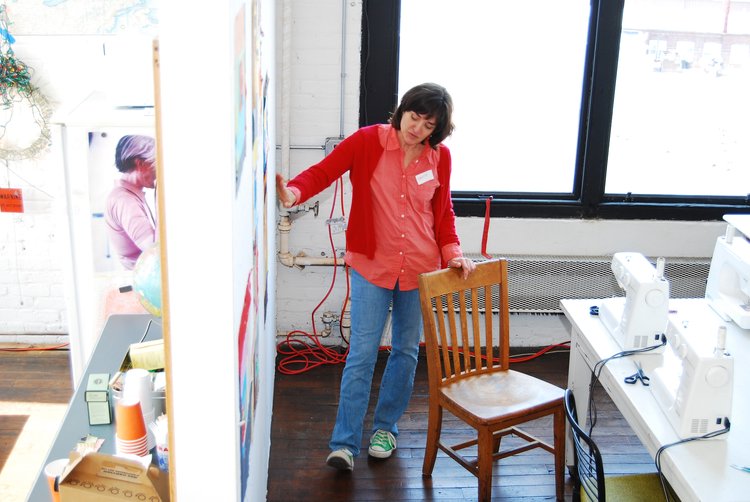
How many quilts do you work on simultaneously? Or do you complete a quilt from start to finish before beginning the next one?
I’m usually working on too many things at once, its the nature of being a creative entrepreneur unfortunately. But there is a sweet spot of balance where you have multiple projects in different stages. There are times of the day when I can write, times when I can do mindless computer work, other times when I need to be moving around and sewing. Having many projects at any time in different stages allows for working on what I’m most effective through the course of the day.
Quilt top design vs. the actual quilting design – Is there a clear leader? How would you describe the differences in your relationship to both of these important design elements in a quilt?
I think my background as a graphic designer makes me focus primarily on the patchwork first. The quilting is an important element that softens or accentuates the patchwork, but usually comes after the top is pieced. I have also designed some wholecloth quilts however, where the quilting design is the impetus.
Wall vs. Bed?
Always the bed!
How would you describe your teaching practice? What do you hope to impart to students?
I love to teach classes that are about process, rather than technique. I feel it’s a more valuable takeaway as you can apply what you learn to almost any craft or activity, and it’s what I’m good at. I like folks to have a rewarding experience, so I try to design the classes so there are “no rough edges”, and try to facilitate the flow away from the places students where students get stuck in deeply ingrained habits. It’s easy enough to be stuck in familiar ruts at home, I think we take workshops to gain new perspectives, to push ourselves out of our comfort zone and learn new ways of seeing and working.
Denyse is teaching “A Different Stripe” as a single-day class on July 21st and 22nd, as well as a four-day Tatter retreat from October 1st-6th in Maine!
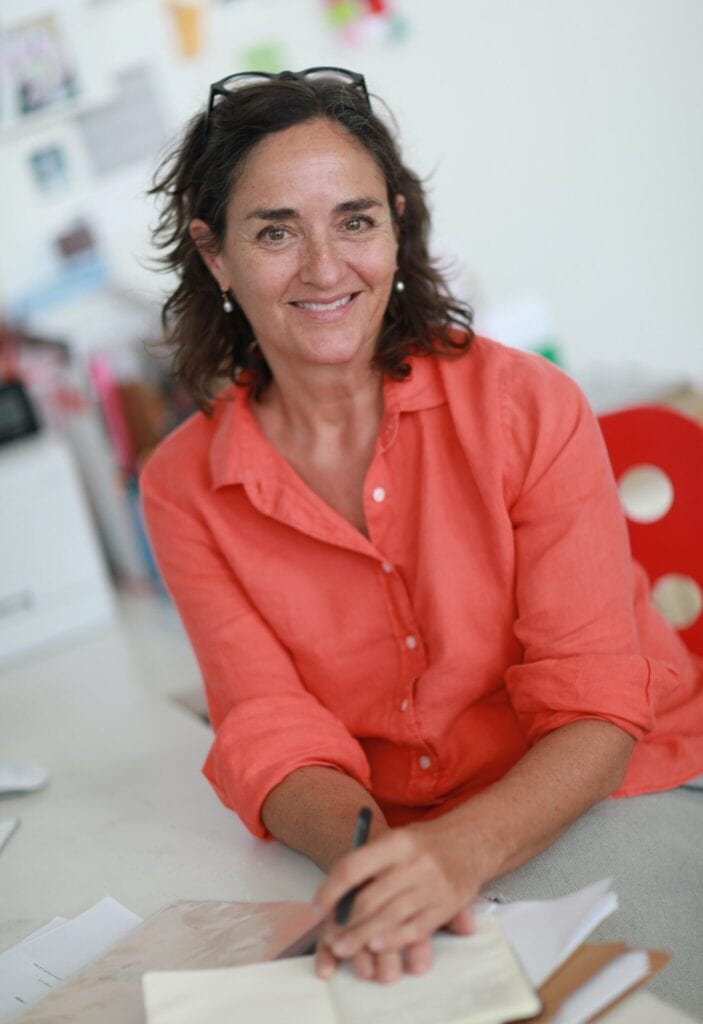
A former graphic designer and graduate of Rhode Island School of Design, Denyse Schmidt has been sewing since she was a young girl. As a professional seamstress, she worked on everything from tutus and bishop’s mitres to fine clothing. Today, she brings these eclectic influences together in patchwork quilts characterized by simple graphics, rich color and quality workmanship. Firmly rooted in the techniques of American quilt-making, Denyse Schmidt reinterprets tradition to make modern functional quilts that are fresh, lively and offbeat.
Denyse’s Couture and custom quilts, in production since 1996, are pieced to order in her studio and hand-quilted by Amish women in Minnesota. Denyse Schmidt Works, a line of machine-quilted quilts, pillows and upholstery fabrics with an industrial-chic aesthetic, was developed in 2003 for the design trade and retail markets. Denyse Schmidt Designs for Sarita Handa, a partnership with Sarita Handa Exports, launched in 2004 with an affordable line of high quality quilts and decorative home accessories. Since 2003, Chronicle Books has brought to market more than a dozen stationary and gift items based on her work, as well as her first how-to book, Denyse Schmidt Quilts, 30 Colorful Quilt and Patchwork Projects. With FreeSpirit Fabrics, Denyse designs fabric collections for independent quilt and fabric stores from 2006-2018. Denyse designs for Windham Fabrics as of 2020. In 2011, her DS Quilts Collection fabric line debuted with record-breaking sales in JoAnn Stores (US) and Spotlight Stores (Australia). In conjunction with her DS Quilts Collection fabrics, Denyse launched quilt patterns featuring her signature style with the venerable McCall Pattern Company. Denyse continues to teach her highly successful improvisational patchwork piecing workshops in her studio.
Schmidt’s studio is located in a historic factory building in Bridgeport CT.
